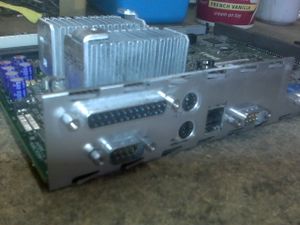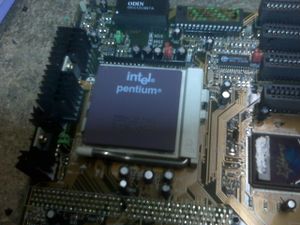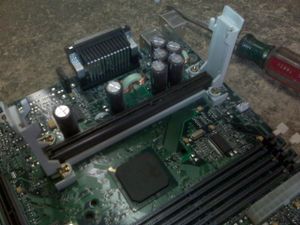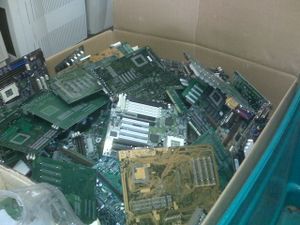Difference between revisions of "Motherboard Recycling"
(as promised, an article about tearing up mobos) |
|||
| (25 intermediate revisions by 4 users not shown) | |||
| Line 1: | Line 1: | ||
| − | '''Motherboard Recycling''' is an | + | {{Migrated}} |
| + | [https://docs.google.com/document/d/1XPPicZjfo3BwoMFQkapRFc_B4oQoaf_9qEG9ktYj_sE/edit?usp=sharing Link] | ||
| + | |||
| + | '''Motherboard Recycling''' is an Advanced Deconstruction process where we take motherboards from the main [[recycling]] operation and turn them into [[Clean Circuitboards]]. | ||
==Safety== | ==Safety== | ||
| Line 6: | Line 9: | ||
==What to remove?== | ==What to remove?== | ||
| − | Your objective is to remove as much as possible from the motherboard: batteries, processors, memory modules, daughtercards, heatsinks, fans, large transformers, faceplates, and | + | Your objective is to remove as much as possible from the motherboard: batteries, processors, memory modules, daughtercards, heatsinks, fans, large transformers, faceplates, and anything else you can get off within a few minutes. |
{| | {| | ||
|[[Image:adv-mobo-recyc - 15.jpg|thumb|Get to work!]] | |[[Image:adv-mobo-recyc - 15.jpg|thumb|Get to work!]] | ||
| Line 26: | Line 29: | ||
====Real Time Clock (RTC)==== | ====Real Time Clock (RTC)==== | ||
This one can be hard to spot, and many motherboards don't have one of these. This device, if present, maintains the system time. It has a built in battery, so pry it off and put it with the other batteries for later sorting. | This one can be hard to spot, and many motherboards don't have one of these. This device, if present, maintains the system time. It has a built in battery, so pry it off and put it with the other batteries for later sorting. | ||
| + | * "The NVRAM battery is a little black box that contains the clock circuit and a small lithium battery. The most common manufacturers of that circuit they are Dallas, Houston Tech, Benchmarq, Odin and ST." -http://www.hardwaresecrets.com/article/81/ | ||
{| | {| | ||
| + | |[[Image:Recycling-real_time_clock1.jpg]] | ||
| + | |||
| + | |[[Image:Recycling-real_time_clock2.jpg]] | ||
| + | |||
| + | |||
|[[Image:adv-mobo-recyc - 04.jpg|thumb|RTC. Many are labeled "Dallas."]] | |[[Image:adv-mobo-recyc - 04.jpg|thumb|RTC. Many are labeled "Dallas."]] | ||
|} | |} | ||
[http://media.maxim-ic.com/images/appnotes/503/timekeeping.jpg Here's a clearer picture of an RTC.] | [http://media.maxim-ic.com/images/appnotes/503/timekeeping.jpg Here's a clearer picture of an RTC.] | ||
| + | |||
====Other==== | ====Other==== | ||
| − | + | There are other batteries you'll encounter too. Here are two examples. First, some older motherboards have Ni-Cd batteries soldered on. Given the age of devices which included these batteries, they've probably leaked some toxic gunk. Wear gloves. And second, many Mac motherboards include a lithium cell in a case that's soldered onto the board. | |
{| | {| | ||
|[[Image:adv-mobo-recyc - 08.jpg|thumb|Ni-Cd mobo battery.]] | |[[Image:adv-mobo-recyc - 08.jpg|thumb|Ni-Cd mobo battery.]] | ||
| + | |[[Image:Power_mac_battery.jpg|thumb|120px|Lithium battery, often found on Mac boards.]] | ||
|} | |} | ||
[http://www.hardwaresecrets.com/imageview.php?image=191 Here's a pic of a leaky one.] | [http://www.hardwaresecrets.com/imageview.php?image=191 Here's a pic of a leaky one.] | ||
| − | === | + | ===CPUs and CPU/Heatsink Combos=== |
| − | Pull the processor. This can be tricky, depending on whether you're dealing with a slot-mounted CPU or a socket | + | Pull the processor. This can be tricky, depending on whether you're dealing with a slot-mounted CPU or a socket CPU. Both kinds have a lever or a catch (or two) you have to find and release before they'll come off. Just remember, this is recycling. If you gouge the motherboard, damage a CPU or break a bracket, no one cares. Just don't hurt yourself. |
| + | |||
| + | ====Socket Procs==== | ||
| + | Socket procs are square and mount flat to the motherboard. They are generally about 1.5" x 1.5". Socket procs (also called ZIFs or Zero Insertion Force CPUs) will have an extruded aluminum heatsink and fan attached to the top of them. Don't be surprised if the heatsink seems humongous compared to the socket proc itself. | ||
| + | *When possible, remove the socket proc from the heatsink/fan. If the removal cannot be done easily with a flat screwdriver, set it aside for later processing. | ||
| + | *If you can easily remove the fan by prying, do so. If not (e.g. need to unscrew 4 screws), set it aside. | ||
{| | {| | ||
| − | |[[Image:adv-mobo-recyc - 03.jpg|thumb|Socket CPU, | + | |[[Image:adv-mobo-recyc - 03.jpg|thumb|Socket CPU, with heatsink/fan removed. Lift the lever and pull the CPU.]] |
| − | |[[Image: | + | |[[Image:cpu_heatsink_wacky.jpg|thumb|If you see a heatsink this, put it in the copper bin.]] |
|} | |} | ||
| + | |||
| + | ====Slot Procs==== | ||
| + | Slot procs are much larger than socket procs (approx 5" x 2") and are mounted vertically on the motherboard. The processor itself generally looks like a small rectangular circuit board. On the motherboard, you'll recognize it as the big vertical thing sticking up almost 3 inches. The processor will be encased in black plastic and have a heatsink/fan attached to it. | ||
| + | |||
| + | *Newer Slot Procs - have tabs along the top edge that slide towards the middle of the CPU to release them. Look for an additional plastic bracket holding the heatsink to the motherboard. The bracket will be long and thin. Pry it off, then rock the CPU assembly as you lift it away from the motherboard. | ||
| + | |||
| + | *Older Slot Procs - are much simpler. Just pull one of the vertical brackets to the side as you lift the CPU assembly off the board with a side-to-side rocking motion. | ||
| + | |||
| + | |||
| + | All CPU mounting hardware must be removed. Remove the plastic bracket by undoing the brass screws at the 4 corners. | ||
| + | |||
| + | {| | ||
| + | |[[Image:adv-mobo-recyc - 05.jpg|thumb|Empty CPU slot]] | ||
| + | |} | ||
| + | |||
===Memory=== | ===Memory=== | ||
Most motherboards will arrive at your station without memory modules. If you see any, pull and set aside. | Most motherboards will arrive at your station without memory modules. If you see any, pull and set aside. | ||
| + | {| | ||
| + | |[[Image:Adv-mobo-recyc - 14.jpg|thumb|Lots and lots of old RAM.]] | ||
| + | |} | ||
| + | |||
===Cards/Other=== | ===Cards/Other=== | ||
| − | You'll see all kinds of stuff, but most motherboards won't have cards or other devices attached by the time they reach you. If you happen accross a weird, unidentifiable hunk of something attached to a motherboard, | + | You'll see all kinds of stuff, but most motherboards won't have cards or other devices attached by the time they reach you. If you happen accross a weird, unidentifiable hunk of something attached to a motherboard, get it off and ask about it. Then update this page with what you learn. |
| − | ===Heatsinks | + | {| |
| − | It's not just the processor that has a heatsink. Almost every PC motherboard's [[ | + | |[[Image:Daughtercard.jpg|thumb|A doohicky attached to the thingamabob.]] |
| + | |} | ||
| + | |||
| + | ===Other Heatsinks=== | ||
| + | It's not just the processor that has a heatsink. Almost every PC motherboard's [[Wikipedia:Northbridge_(computing)|Northbridge]] chip has a heatsink glued to it. Pry that sucker off. | ||
{| | {| | ||
|[[Image:adv-mobo-recyc - 01.jpg|thumb|Northbridge heatsink.]] | |[[Image:adv-mobo-recyc - 01.jpg|thumb|Northbridge heatsink.]] | ||
|} | |} | ||
| + | |||
| + | You may find other heatsinks that look like they have fingers. These heatsinks are made of sheet aluminum. Remove them as well. | ||
| + | |||
==What do I do with all this stuff?== | ==What do I do with all this stuff?== | ||
| Line 64: | Line 106: | ||
(This section is incomplete) | (This section is incomplete) | ||
| − | *CPU's | + | *CPU's - Must not have anything attached. No plastic, heatsink, etc. |
| − | *Memory | + | **Slot CPUs go in a specific bucket. |
| − | *Heatsink/ | + | **Socket CPUs go in a specific bucket. Extract from plastic housing when necessary |
| − | * | + | |
| + | *Memory - in a separate bucket. | ||
| + | |||
| + | *Heatsink/Fan/CPU Combos | ||
| + | **Squarish ones from ZIF Processors (smaller square CPUs) have their own container. | ||
| + | **Slot Processors (larger rectangular CPUs) have their own container. | ||
| + | See also [Heatsink/Fan/CPU Combo Recycling - to be written] | ||
| + | * | ||
*(more to be added later) | *(more to be added later) | ||
[[Category:Recycling]] | [[Category:Recycling]] | ||
| + | [[Category:Howto]] | ||
Latest revision as of 17:22, 16 May 2014
|
This page has been migrated to a document on Free Geek's Google Drive. Information remaining behind may no longer be relevant. MIGRATOR: When you have tagged this page as migrated, (Link to new page immediately below.) |
Motherboard Recycling is an Advanced Deconstruction process where we take motherboards from the main recycling operation and turn them into Clean Circuitboards.
Safety
The Safety Introduction from the basic deconstruction page applies here. In particular, wear safety glasses: no heatsinks are permitted in your eye.
What to remove?
Your objective is to remove as much as possible from the motherboard: batteries, processors, memory modules, daughtercards, heatsinks, fans, large transformers, faceplates, and anything else you can get off within a few minutes.
Hardware
Any screws, plastic clips, faceplates or other hardware must be removed from the motherboard.
Batteries
Not all batteries look like batteries. Here are a few examples of batteries or devices which contain batteries. Remove anything that looks remotely like one of these.
Button
This is the most common battery you'll find on a motherboard. Wedge a screwdriver in there and pop it out for later sorting.
Real Time Clock (RTC)
This one can be hard to spot, and many motherboards don't have one of these. This device, if present, maintains the system time. It has a built in battery, so pry it off and put it with the other batteries for later sorting.
- "The NVRAM battery is a little black box that contains the clock circuit and a small lithium battery. The most common manufacturers of that circuit they are Dallas, Houston Tech, Benchmarq, Odin and ST." -http://www.hardwaresecrets.com/article/81/
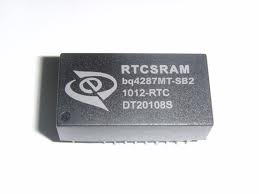
|
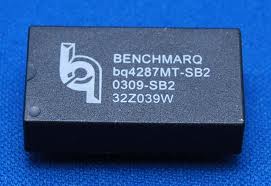
|
Here's a clearer picture of an RTC.
Other
There are other batteries you'll encounter too. Here are two examples. First, some older motherboards have Ni-Cd batteries soldered on. Given the age of devices which included these batteries, they've probably leaked some toxic gunk. Wear gloves. And second, many Mac motherboards include a lithium cell in a case that's soldered onto the board.
CPUs and CPU/Heatsink Combos
Pull the processor. This can be tricky, depending on whether you're dealing with a slot-mounted CPU or a socket CPU. Both kinds have a lever or a catch (or two) you have to find and release before they'll come off. Just remember, this is recycling. If you gouge the motherboard, damage a CPU or break a bracket, no one cares. Just don't hurt yourself.
Socket Procs
Socket procs are square and mount flat to the motherboard. They are generally about 1.5" x 1.5". Socket procs (also called ZIFs or Zero Insertion Force CPUs) will have an extruded aluminum heatsink and fan attached to the top of them. Don't be surprised if the heatsink seems humongous compared to the socket proc itself.
- When possible, remove the socket proc from the heatsink/fan. If the removal cannot be done easily with a flat screwdriver, set it aside for later processing.
- If you can easily remove the fan by prying, do so. If not (e.g. need to unscrew 4 screws), set it aside.
Slot Procs
Slot procs are much larger than socket procs (approx 5" x 2") and are mounted vertically on the motherboard. The processor itself generally looks like a small rectangular circuit board. On the motherboard, you'll recognize it as the big vertical thing sticking up almost 3 inches. The processor will be encased in black plastic and have a heatsink/fan attached to it.
- Newer Slot Procs - have tabs along the top edge that slide towards the middle of the CPU to release them. Look for an additional plastic bracket holding the heatsink to the motherboard. The bracket will be long and thin. Pry it off, then rock the CPU assembly as you lift it away from the motherboard.
- Older Slot Procs - are much simpler. Just pull one of the vertical brackets to the side as you lift the CPU assembly off the board with a side-to-side rocking motion.
All CPU mounting hardware must be removed. Remove the plastic bracket by undoing the brass screws at the 4 corners.
Memory
Most motherboards will arrive at your station without memory modules. If you see any, pull and set aside.
Cards/Other
You'll see all kinds of stuff, but most motherboards won't have cards or other devices attached by the time they reach you. If you happen accross a weird, unidentifiable hunk of something attached to a motherboard, get it off and ask about it. Then update this page with what you learn.
Other Heatsinks
It's not just the processor that has a heatsink. Almost every PC motherboard's Northbridge chip has a heatsink glued to it. Pry that sucker off.
You may find other heatsinks that look like they have fingers. These heatsinks are made of sheet aluminum. Remove them as well.
What do I do with all this stuff?
After a few hours, you'll have a pile of clean(er) motherboards in the gaylord in front of you, and a bunch of stuff. Here's what to do with all the stuff.
(This section is incomplete)
- CPU's - Must not have anything attached. No plastic, heatsink, etc.
- Slot CPUs go in a specific bucket.
- Socket CPUs go in a specific bucket. Extract from plastic housing when necessary
- Memory - in a separate bucket.
- Heatsink/Fan/CPU Combos
- Squarish ones from ZIF Processors (smaller square CPUs) have their own container.
- Slot Processors (larger rectangular CPUs) have their own container.
See also [Heatsink/Fan/CPU Combo Recycling - to be written]
- (more to be added later)



